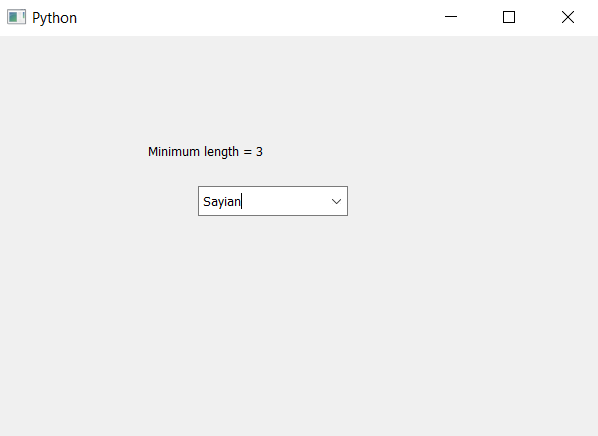En este artículo veremos cómo podemos obtener la longitud mínima para los elementos del cuadro combinado, es decir, esta propiedad contiene el número mínimo de caracteres que deben caber en el cuadro combinado. Para hacer esto, usaremos el método setMinimumContentsLength, por defecto, la longitud mínima del cuadro combinado es 0.
Para obtener la longitud mínima del contenido, usaremos el método minimalContentsLength.
Sintaxis: combo_box.minimumContentsLength()
Argumento: no toma ningún argumento
Retorno: devuelve un número entero
A continuación se muestra la implementación:
Python3
# importing libraries
from PyQt5.QtWidgets import *
from PyQt5 import QtCore, QtGui
from PyQt5.QtGui import *
from PyQt5.QtCore import *
import sys
class Window(QMainWindow):
def __init__(self):
super().__init__()
# setting title
self.setWindowTitle("Python ")
# setting geometry
self.setGeometry(100, 100, 600, 400)
# calling method
self.UiComponents()
# showing all the widgets
self.show()
# method for widgets
def UiComponents(self):
# creating a combo box widget
self.combo_box = QComboBox(self)
# setting geometry of combo box
self.combo_box.setGeometry(200, 150, 150, 30)
# geek list
geek_list = ["Sayian", "Super Saiyan", "Super Sayian 2",
"Super Sayian B"]
# making it editable
self.combo_box.setEditable(True)
# adding list of items to combo box
self.combo_box.addItems(geek_list)
# setting minimum content length
self.combo_box.setMinimumContentsLength(3)
# getting minimum content length
mini = self.combo_box.minimumContentsLength()
# creating label to show minimum length
label = QLabel("Minimum length = " + str(mini), self)
# setting geometry of the label
label.setGeometry(150, 100, 350, 30)
# create pyqt5 app
App = QApplication(sys.argv)
# create the instance of our Window
window = Window()
# start the app
sys.exit(App.exec())
Producción :

Publicación traducida automáticamente
Artículo escrito por rakshitarora y traducido por Barcelona Geeks. The original can be accessed here. Licence: CCBY-SA